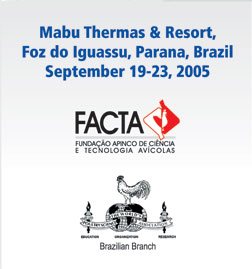| |
Plenary
Lectures
Genome
sequence of the avian coccidiosis-causing agent, Eimeria
tenella
Bart Barrell1, Matt Berriman1, Arthur
Gruber2, Al Ivens1, Marie-Adèle Rajandream1,
Pierre Rivailler3, Martin Shirley3, Fiona Tomley3.
1Wellcome Trust Sanger Institute, Genome Campus, Hinxton,
CB10 1SA, UK
2 University of Sao Paulo, Faculty of Vet.Medicine and
Zootechny, Av. Prof. Orlando Marques de Paiva 87, Sao
Paulo - SP - Brazil - 05508-000
3 Institute for Animal Health, Compton, Newbury, Berkshire,
RG20 7NN, UK
Eimeria spp are major pathogens
of intensely reared livestock. Drug resistance in the
parasite is increasing and no new drugs have been introduced
for more than 10 years. Live vaccination is effective
but difficult to implement due to the large number of
chicken required in the manufacture. Recombinant vaccines
are desirable but their discovery will be preceded by
a detailed molecular knowledge of the parasite.
Against this backdrop,
a project to sequence the entire genome of Eimeria tenella
was started in 2002. Whole genome shotgun sequencing
has produced contiguous sequences totalling 58 Mb in
length. Predicting the genes is the next challenge.
Although distantly related to other Apicomplexan parasites
that have been subjected to genome sequencing, Eimeria
is the most complex yet. The base composition of the
genome is unusual and the gene structures are complex.
Gene predictions can be browsed, searched or downloaded
via the GeneDB database (http://www.genedb.org/Eimeria),
allowing scientists working on Eimeria to quickly access
genes of interest to their own research, such as enzymes,
ligands, transporters or surface proteins. Detailed
annotation of the genes will allow aspects of the organism’s
biology to be reconstructed in silico, for instance
to gain insights into pathways that would take years
to characterise in vitro or in vivo.
The genome
sequence provides a framework to underpin scientific
research, not only accelerating hypothesis driven research
but also generating hypotheses for further investigation.
back | print
|
|
